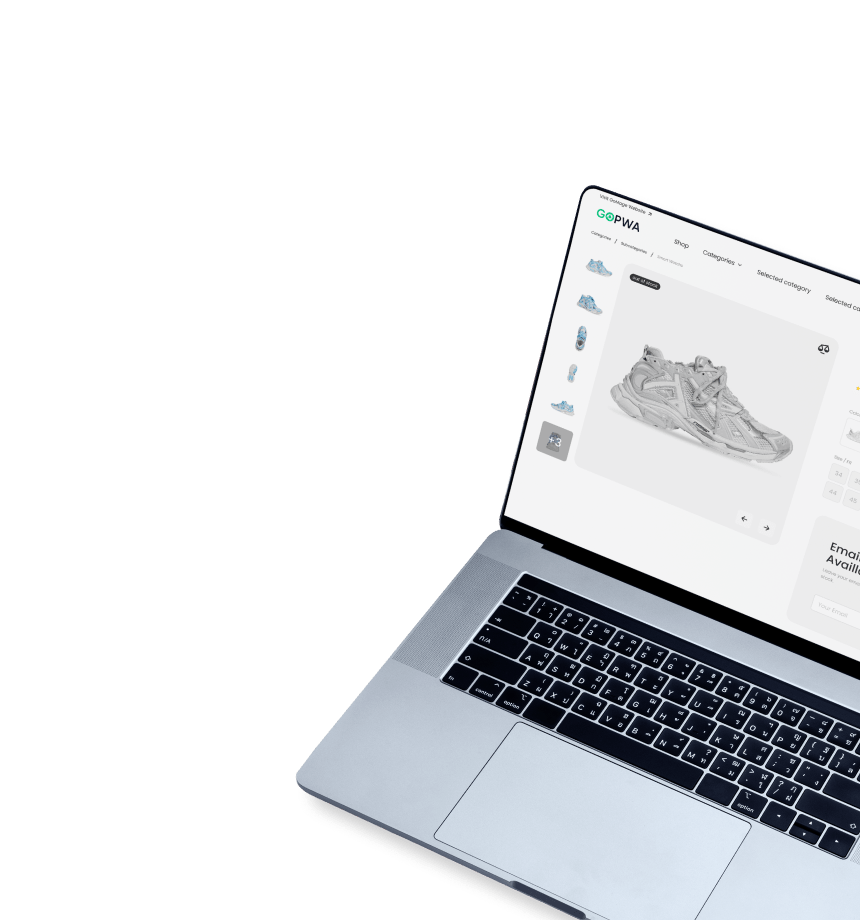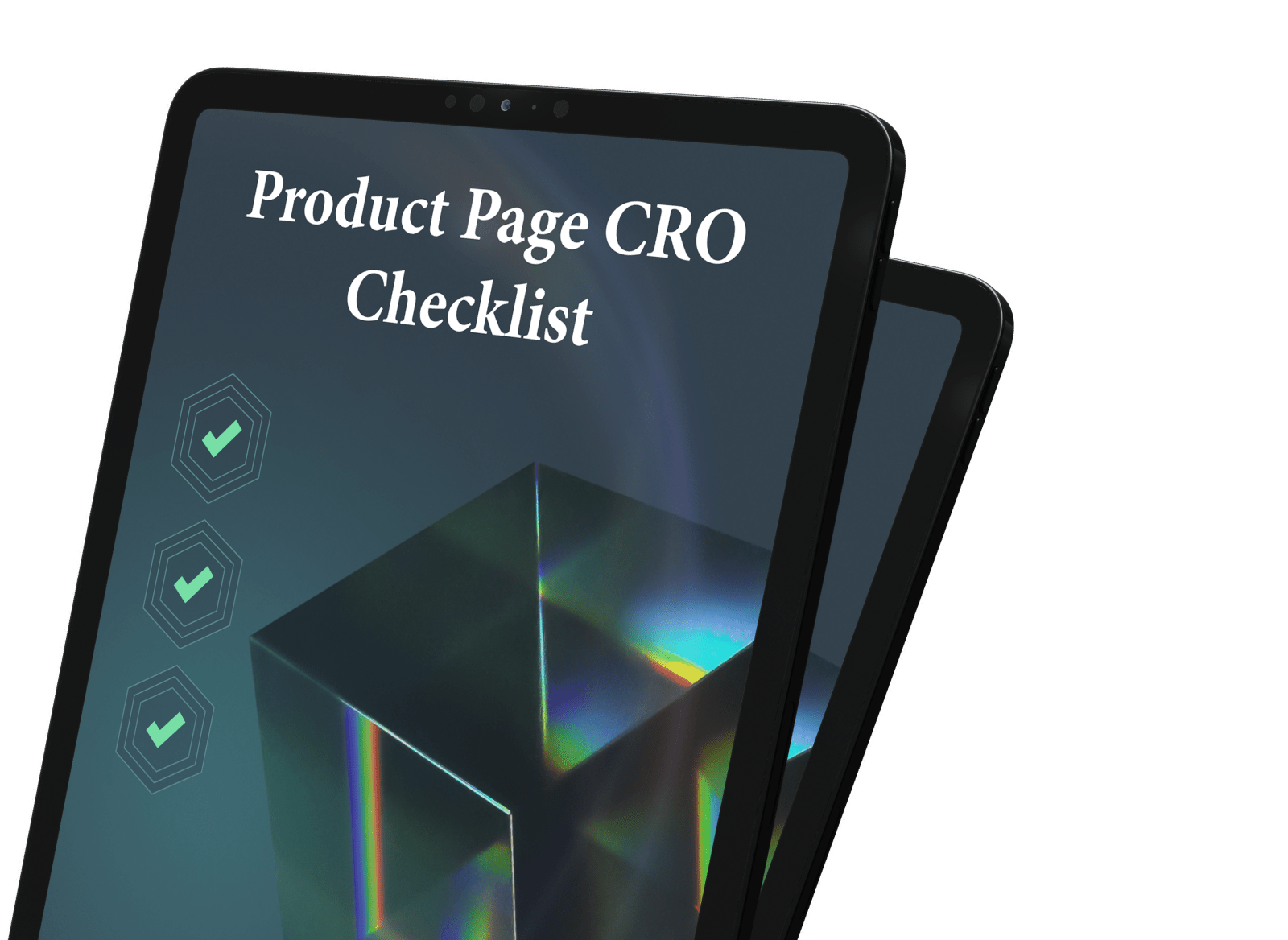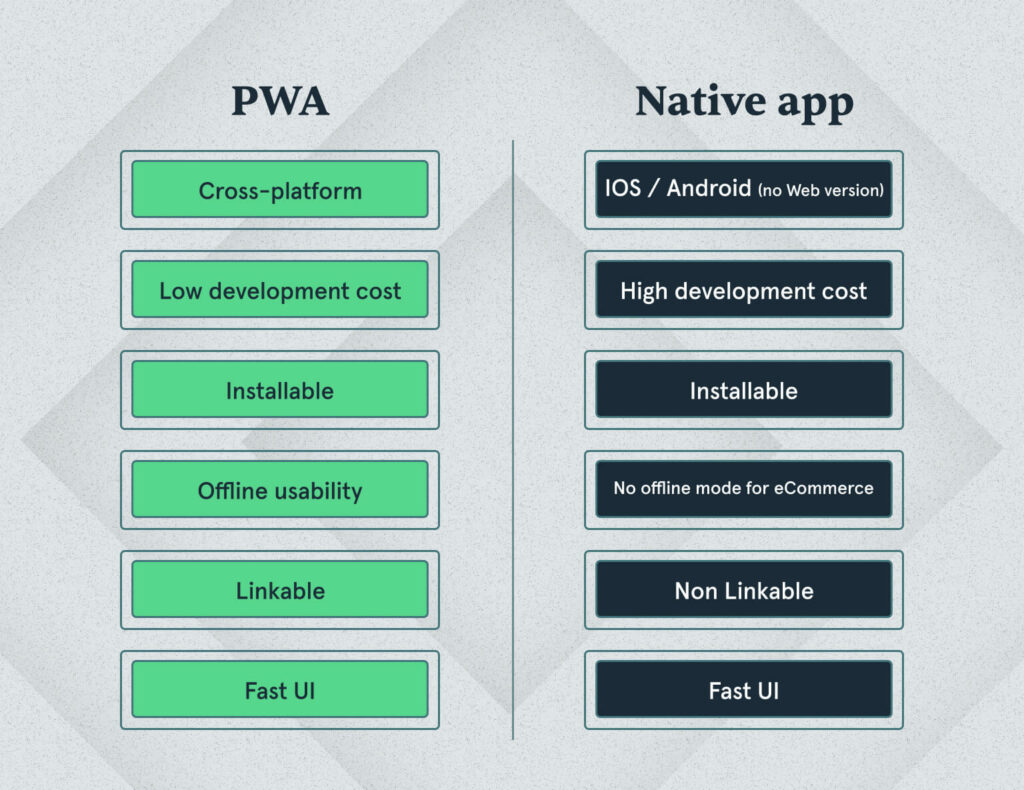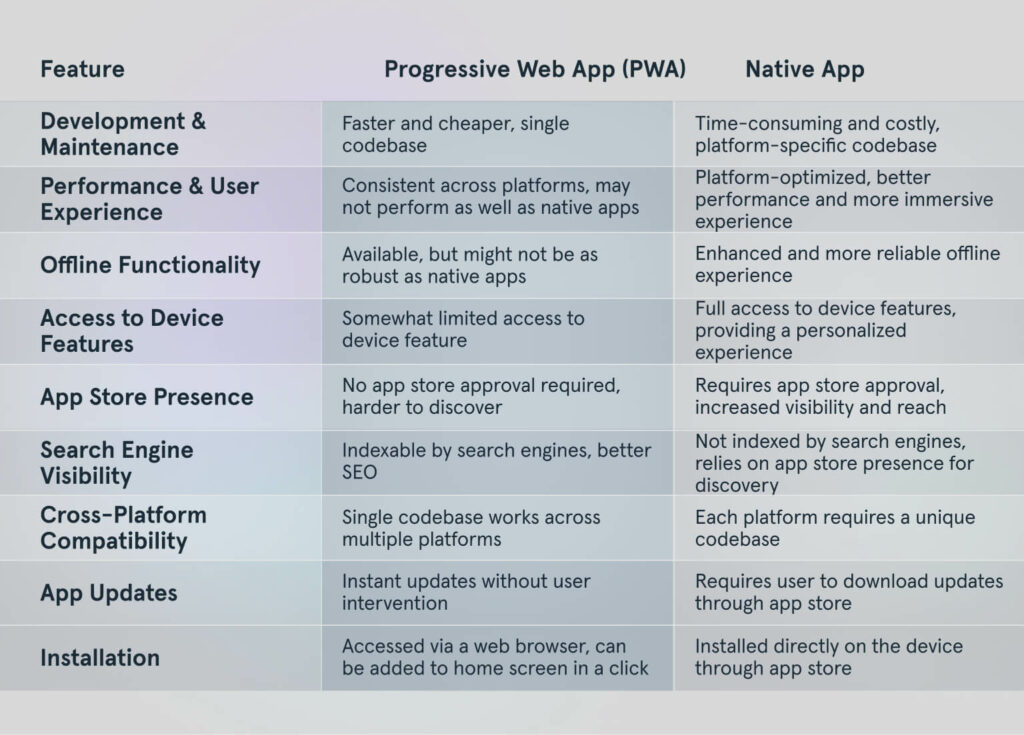Today, 3.5 billion people worldwide are users of smartphones with the number predicted to grow to 3.8 billion the next year.
In 2018, mobile sales accounted for nearly 40% of all Commerce sales in the USA.
Mobile presence is important for every eCommerce business that doesn’t want to lose potential customers. Luckily, there are multiple ways to engage in mCommerce. Native apps might be the first to come to mind, but are they the only option?
In this article, we’ll compare some of the most prominent examples for eCommerce – PWA vs. native apps. You will learn which technology is superior and which one will be the best fit for mobile commerce. Read the article to learn about the following aspects:
- What are PWA vs. native apps?
- The benefits of Magento PWA development
- How PWA vs. native app are similar and different
- The best solution for eCommerce
- GoMage’s Experience in PWA development
Let’s discover key technical and business details!
Development Get a robust PWA
Supercharge your eCommerce efforts with superb UX and ‘superfast’ speed. Build an eCommerce PWA from scratch or save time and money using GoPWA Storefront.

PWA vs. Native App: The Basics
Before diving into the differences between progressive web apps and native apps, let’s first define these terms and understand their primary characteristics.
What is a Native App?
A native app is a mobile application specifically built for a particular platform, such as iOS or Android. During the creation of native apps, developers use a programming language specific for that platform – Objective C or Swift for iOS devices and Kotlin or Java for Android apps.
The main benefit of native mobile apps is an engaging user experience and robust features designed specifically for an operating system. Such applications can be installed on users’ devices, such as a smartphone or tablet and, depending on how they are built, can work in offline mode. Native app integrates seamlessly with the device hardware, allowing you to utilize the camera, GPS and other advanced smartphone features, and send push notifications.
With a native app, you need to submit it to Google Play or the Apple’s App Store for review, pass all the requirements, do app store optimization to make your application available to mobile users, and stay compliant all the time while your app is available on an app store.
What is a PWA?
Progressive Web Application (PWA) combines the best features of mobile applications and websites. A PWA is built with such web technologies as JavaScript, HTML, and CSS. PWAs are a strong competitor to native apps, as they provide the same level of end user experience.
However, progressive web apps have a few differences compared with native apps. By building a PWA, you shorten the development timeframe and save money. Instead of releasing a responsive website, an iOS and Android app, you can create a single progressive web application that will work on all modern devices and screen sizes. PWAs offer such benefits as push notifications, lower storage space requirements, seamless work across multiple operating systems, and access to platform specific tools.
Let’s take a close look at PWA vs. native app differences. You will better understand the value of a progressive web app and why big companies are already adopting this technology.
If you prefer to learn from the video content, check our video explaining Progressive Web Apps and their benefits for eCommerce.
What are the Key Differences Between a PWA and a Native App?
Now that we’ve covered the basics, let’s delve into the main differences between PWAs and native apps, focusing on five key areas: development and maintenance, performance and mobile web experience, offline usage, app store presence, and search engine visibility.
Development and Maintenance
- PWA: Developing a PWA generally requires less time and resources compared to native apps for mobile devices. Since progressive web apps are built using web technologies, a single codebase can be used across different platforms, making it easier and more cost-effective to maintain.
- Native app: Native application development demands a separate codebase for each platform, which can be time-consuming and costly. However, native mobile applications allows for better optimization and a more tailored user experience on each platform.
Development Cost
- PWA: The development of progressive web apps is cheaper than the development of a native app, as you don’t need to create separate apps for each operating system (iOS and Android). Even more, the time needed for development will be at least two times shorter.
- Native app: When you develop a native app, you need to create two code bases for each mobile platform, which is quite time and resources consuming. After the development, you will need to maintain and support each version.
Performance and User Experience
- PWA: PWAs offer a consistent experience across different devices and platforms, but they may not perform as well as native apps. PWAs can still deliver a smooth and responsive experience and, compared to website and web applications, they show higher speed.
- Native app: Native apps generally provide a faster and more seamless user experience since they are specifically designed for a particular platform. They can also take full advantage of device features, resulting in a more engaging and personalized experience for users.
Offline Support
- PWA: PWAs can work offline, thanks to service workers and caching that allow users to access essential features and content even when they lose internet connectivity. However, the offline capabilities of PWAs might not be as robust as those of native apps.
- Native app: Native apps usually offer better offline functionality, as they can store more data locally on the device. This allows users to access more features and content without an internet connection, providing a more reliable experience in areas with poor or no connectivity.
App Stores Presence
- PWA: PWAs don’t require Android’s or Apple’s app store approval and app store optimization, making it easier and faster to launch and update them. Users can access PWAs directly from their browsers or add them to their home screens for quick access. However, you can still add your PWA to different app stores if there is such a need or desire.
- Native app: Native apps are distributed through app stores, which can help increase visibility and reach. However, this also means that developers must adhere to the app store guidelines and go through the app review process, which can be time-consuming and restrictive.
Search Engine Visibility
- PWA: PWAs are indexable by search engines, which can make it easier for users to find your eCommerce site. This can lead to better SEO and higher organic search rankings.
- Native app: While native apps can be discovered through app stores, they are not indexed by search engines like PWAs. This means that users searching on the web won’t be able to find your native app as easily as a PWA.
PWA vs Native App: Customer’s Perspective
Understanding how users perceive and interact with PWAs and native apps is crucial when deciding which option to choose for your eCommerce business. Let’s explore the user’s perspective on both options.
Accessibility and Discoverability
- PWA: Users can access PWAs directly via their web browser without needing to download an app from an app store. This makes it easy for users to visit your eCommerce site, especially if they find it through search engine results. However, the lack of app store presence may make it slightly harder for users to discover your PWA compared to a native app.
- Native App: Native apps are found in app stores, which can make them more visible and easily discoverable by users. However, downloading and installing the app requires extra steps, and users may need to free up storage space on their devices.
User Experience
- PWA: PWAs offer a consistent user experience across different platforms and devices, which can be beneficial for users who switch between devices. However, PWAs may not provide the same level of performance and access to device features as native apps.
- Native App: Native apps are tailored to their specific platforms, providing a more immersive and personalized user experience. They generally offer better performance and more access to smartphone features, such as notifications and geolocation services.
App Updates
- PWA: PWAs update automatically without any action needed from the user, ensuring that users always have access to the latest features and improvements.
- Native App: Users need to download and install updates for native apps through app stores, which can be a more time-consuming process. Users may also choose to delay or skip updates, leading to potential compatibility or security issues.
Offline Mode
- PWA: PWAs offer offline work, allowing users to access essential features and content when they lose internet connectivity. However, the offline capabilities of PWAs might not be as robust as those of native apps.
- Native App: Native mobile apps usually provide better offline capabilities, enabling users to access more features and content without an internet connection on mobile devices. This can be particularly useful for users in areas with poor or no connectivity.
In most cases, iOS or Android users won’t see a difference between using PWA hybrid apps or native apps. When users interact with an app, they care about their experience rather than system settings and technologies that underlie the solution.

Pros and Cons of Progressive Web Apps vs. Native Apps
Now that we’ve covered the key differences between PWAs and native apps, let’s summarize their respective pros and cons.
Progressive Web Apps
Pros of PWAs:
- Faster and cheaper development and maintenance
- Consistent experience across platforms
- Offline mode
- No app store approval required
- Search engine visibility
- Save storage space
Cons of PWAs:
- May not perform as well as native apps
- Limited access to device features
Native Applications
Pros of native apps:
- Better performance and user experience
- Enhanced offline capabilities
- Access to device features
- Increased visibility through app store presence
Cons of native apps:
- Time-consuming and costly development and maintenance
- Platform-specific codebase
- App store approval required
- Not indexed by search engines
Deciding the Right Fit for Your eCommerce Business
When choosing between a PWA and a native app for your eCommerce business, consider the following factors:
- Budget and resources: If you have limited resources, a PWA might be a more cost-effective solution.
- Target audience: Consider the platforms and devices your target audience uses, as well as their preferences and behavior. If you need cross platform availability, it’s best to go with a progressive web app to save time and money. For example, not all PWA storefront offer the support of push notifications.
- Features and functionality: Assess the features and functionality you want to offer and whether a PWA or native app can better support them.
- User experience: Before developing apps, determine whether your priority is a consistent experience across platforms (PWA) or a more tailored and immersive experience (native app).
In conclusion, progressive web applications are a great way for expanding eCommerce business into the mCommerce realm on a tight budget and timeline.
Successful Use Cases of PWA in eCommerce
Several eCommerce companies have successfully implemented PWAs, leveraging their advantages to enhance customer experience, increase engagement, and boost sales. Let’s take a look at some real-world examples and the results these businesses achieved thanks to PWA development.
GoodCook
GoodCook is one of the leading producers of homeware products in the USA. Trying to adapt to the recent changes in consumer behavior, GoodCook changed its business strategy and enhanced DTC (Direct-to-Consumer) efforts.
With the help of GoMage, the company turned their WordPress blog into a PWA in under 5 months. The change allowed them to reduce bounce rate by 25%, increase average session duration by 30% and boost the number of pages viewed by 66%.
Check the full story of GoodCook’s transformation from a WordPress blog into a PWA in the video.
Alibaba
Alibaba, the global eCommerce giant, adopted a PWA to improve the mobile shopping experience for its users. The company aimed to reach customers who had limited storage space on their devices or faced network issues. With the implementation of a PWA, Alibaba saw a significant increase in user engagement, with a 76% higher conversion rate for mobile users.
Flipkart
India’s leading eCommerce platform, Flipkart, adopted a PWA called Flipkart Lite to provide a seamless and faster browsing experience for their users. As a result, Flipkart experienced a 70% increase in conversions, a 40% decrease in bounce rate, and a three-fold increase in time spent on the platform.
Lancôme
Luxury cosmetics brand Lancôme developed a PWA to reach a broader audience and improve its mobile shopping experience. The PWA’s implementation led to a 17% increase in conversions, a 51% increase in mobile sessions, and an 8% decrease in bounce rates. Lancôme also saw a 15% decrease in page load times, resulting in a more satisfying user experience.
Starbucks
Starbucks adopted a PWA for its online ordering system to provide a fast, reliable, and engaging experience for its customers. The Starbucks PWA allowed users to browse the menu, customize their orders, and make payments even in areas with poor or no connectivity. This resulted in a nearly 100% increase in daily active users and a significant boost in the number of orders placed through the platform.
These examples showcase how eCommerce companies from various industries have successfully integrated PWAs into their digital strategies, leading to improved user experiences, increased engagement, and higher conversion rates. By considering the unique benefits of PWAs and aligning them with your business goals, you can unlock new opportunities for growth and success in the eCommerce landscape.
Development Get a robust PWA
Supercharge your eCommerce efforts with superb UX and ‘superfast’ speed. Build an eCommerce PWA from scratch or save time and money using GoPWA Storefront.

How We Can Help You With PWA Development
As you weigh the pros and cons of PWAs and native apps, it’s essential to work with a team that understands the unique requirements of eCommerce businesses and has proven experience in PWA development. That’s where GoMage comes in.
At GoMage, we specialize in creating cutting-edge eCommerce webstores that sell, and our expertise in PWA development sets us apart from the competition. We have a deep understanding of the intricacies and challenges of building PWAs that cater to the ever-evolving demands of the eCommerce landscape. Our team of skilled developers and designers are dedicated to delivering PWAs that not only meet but exceed your expectations.
Our product, GoPWA Storefront, is a testament to our commitment to excellence in PWA development. GoPWA Storefront is a customizable and feature-rich PWA solution designed specifically for eCommerce businesses. It offers a seamless, native mobile app-like experience for your customers while providing all the benefits of PWAs, such as fast loading times, offline mode, and improved search engine visibility.
With GoPWA Storefront, you can enjoy the following benefits:
- A fully responsive design that adapts to any device, ensuring a consistent and engaging user experience across platforms
- Enhanced performance, thanks to advanced caching and optimization techniques
- The ability to leverage native device features and functionality, such as push notifications and geolocation
- A user-friendly admin panel that allows you to easily manage and customize your storefront without any coding knowledge
- Seamless integration with popular eCommerce platforms and third-party extensions, ensuring a smooth and hassle-free implementation process
- Ongoing support and updates from our dedicated team of PWA experts, who are committed to helping your eCommerce business succeed
At GoMage, we understand that every eCommerce business is unique, which is why our PWA solutions are tailored to meet your specific needs and goals. Whether you’re a small business owner looking for an affordable alternative to native apps or a large enterprise seeking a scalable and future-proof solution, our team at GoMage is here to help you make the most of PWA technology.
Don’t let the complexities of PWA vs. native app development hold you back from providing the best possible experience for your customers. Reach out to our team at GoMage today to discuss your requirements and explore how our GoPWA Storefront solution can help reduce the time and money needed to develop a progressive web app. We’ll help you build a PWA from scratch or with PWA migration.
PWA vs. Native App: Key Takeaways
In the end, there is no one-size-fits-all solution when it comes to choosing between a progressive web app and a native app for your eCommerce business. Both native apps and progressive web apps have their own set of advantages and disadvantages, and the best choice will depend on your unique requirements and objectives.
By carefully evaluating the key differences between a progressive web app and native app and considering the factors discussed throughout this article, you can make a well-informed decision that will help your eCommerce business succeed in today’s competitive digital landscape.
If you need help with eCommerce PWA development, drop us a line to get a free consultation with PWA experts.









